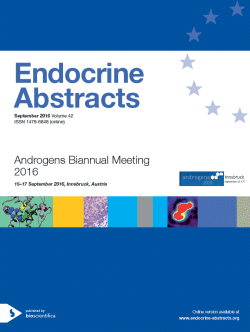Searchable abstracts of presentations at key conferences in endocrinology
Androgens Biannual Meeting 2016
<emphasis role="bold">Invited Lectures</emphasis>
ea0042il1 | <emphasis role="bold">Invited Lectures</emphasis> | Androgens2016
Determinants and clinical correlates of androgen exposure: phases of life and disease
The relation between testosterone (T) production and action is complex, involving protein binding in the circulation affecting clearance and tissue availability, T production from precursors in peripheral tissues, deactivating and activating (to dihydrotestosterone and estradiol) metabolism within target tissues, besides factors affecting androgen responsiveness (receptor concentrations, cofactors, genetics,…). Yet, in absence of a useful independent marker of androgen a...
ea0042il2 | <emphasis role="bold">Invited Lectures</emphasis> | Androgens2016
Neuro-inflammatory origins of the sexual differentiation of the brain
During development, surges in testosterone (T) organize the bipotential anlage of the periphery into the male phenotype. The same T surges also act on the preoptic area (POA) and hypothalamus of the brain to prevent the expression of female sex behavior and promote male behavior in adulthood so that the behavioral and anatomical phenotypes match. In the rodent, T actually serves as a prohormone. Once in the brain, T is aromatized to the quintessential female hormone estradiol ...




